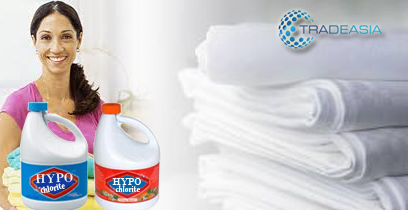What is Sodium Hypochlorite
Sodium Hypochlorite is a chemical compound with the formula NaOCl. Sodium hypochlorite solution, commonly known as bleach, is frequently used as a disinfectant and as a bleaching agent. Liquid chlorine; usually provides 10% to 12% available chlorine; has a pH of 13 and requires that small amounts of acid be added to the pool to neutralize the high pH. Good for regular chlorination and superchlorination. Not recommended for spas. Does not contain conditioner or stabilizer to protect it from sunlight, but it is protected if stabilizer or conditioner is already in the water

Like all hypochlorites, sodium hypochlorite is a salt of hypochlorous acid, HClO. sodium hypochlorite solution is a light yellow green transparent liquid. In water, it completely dissociates into the sodium cation Na+ and the hypochlorite anion ClO−, while a small portion hydrolyses into sodium hydroxide and hypochlorous acid. The oxidizing power of the latter and of the hypochlorite anion cause the bleaching effect. The hypochlorite anion’s negative charge, however, prevents it from diffusing through the cell walls of bacteria and microbes, making it a poor disinfectant.
However, the hypochlorous acid molecules that exist in equilibrium with the hypochlorite anion, due to their neutral charge and small size, easily diffuse through the cell walls of bacteria. This changes the oxidation-reduction potential (ORP) of the cell, and inactivates the enzyme triosephosphate dehydrogenate. Triosephosphate dehydrogenase (or glyceraldehyde 3-phosphate dehydrogenate/GAPDH) is essential for the digestion of glucose, but is particularly sensitive to oxidizing agents. Its inactivation effectively destroys the micro-organism’s ability to function.

The Uses of Sodium Hypochlorite
In household bleach form, sodium hypochlorite is used for removal of stains from laundry. It is particularly effective on cotton fiber, which stains easily but bleaches well. 50 to 250 ml per load is usually recommended for a standard-size washer. Hot water increases the activity of the bleach, owing to the thermal decomposition of hypochlorite which ultimately generates environmentally-undesirable chlorate.A weak solution of 1% household bleach in warm water is used to sanitize smooth surfaces prior to brewing of beer or wine. Surfaces must be rinsed to avoid imparting flavors to the brew; these chlorinated byproducts of sanitizing surfaces are also harmful.
Sodium hypochlorite has been used for the disinfection of drinking water, at a concentration equivalent to about 1 liter of household bleach per 4000 liters of water is used. The exact amount required depends on the water chemistry, temperature, contact time, and presence or absence of sediment. In large-scale applications, residual chlorine is measured to titrate the proper dosing rate. For emergency disinfection, the US EPA recommends the use of 2 drops of 5%ac household bleach per quart of water. If the treated water doesn’t smell of bleach, 2 more drops are to be added.
It is also used in dentistry, during root canal treatment, disinfecting the canal and dissolving any remaining pulp tissue. Historically, Henry Drysdale Dakin’s solution (0.5%) had been used. Nowadays, 2.5-5.25% solutions are being used. An alkaline solution (pH 11.0) of sodium hypochlorite is used to treat dilute (< 1 g/L) cyanide wastewater, e.g. rinsewater from an electroplating shop. In batch treatment operations, sodium hypochlorite has been used to treat more concentrated cyanide wastes, such as silver cyanide plating solutions. A well-mixed solution is fully treated when an excess of chlorine is detected.
Product Identification
- Synonyms
- CAS No.
- Molecular Weight
- Chemical Formula
- hypochlorous acid sodium salt, sodium hydrochlorite, sodium chloride oxide, sodium oxychloride clorox
- 7681-52-9
- 74.44
- NaOCl
Physical and Chemical Properties
- Physical state
- Odor
- Color
- pH (1% soln/water)
- Boiling Point
- Specific Gravity
- Vapor Pressure
- Vapor Density
- Dispersion Properties
- Solubility
- Liquid.
- Characteristic. Chlorine-like (Slight.)
- Colorless to light greenish yellow
- Neutral.
- Decomposition temperature: 40°C (104°F)
- 1.07 - 1.093 (Water = 1)
- 2.3 kPa (@ 20°C)
- The highest known value is 0.62 (Air = 1) (Water)
- See solubility in water.
- Easily soluble in cold water.
Sales Specification
- Sodium Hypochlorite Specifications (Filtered) for 12 Trade Percent Available Chlorine
- Formula
- Grams Per Liter
- Specific Gravity Range
- % by Weight Excess Sodium Hydroxide
- Weight % Available Chlorine
- NaOCl in water
- 120 GPL
- 1.159-1.164
- 0.1-0.4
- 10.356-10.311*
